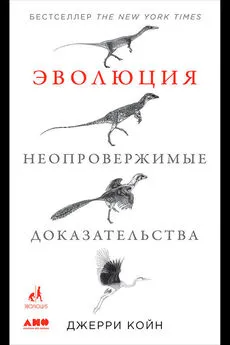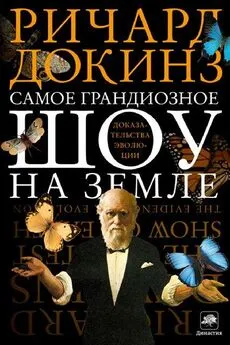Джерри Койн - Эволюция: Неопровержимые доказательства
- Название:Эволюция: Неопровержимые доказательства
- Автор:
- Жанр:
- Издательство:Альпина нон-фикшн
- Год:2018
- Город:Москва
- ISBN:978-5-9614-5002-6
- Рейтинг:
- Избранное:Добавить в избранное
-
Отзывы:
-
Ваша оценка:
Джерри Койн - Эволюция: Неопровержимые доказательства краткое содержание
Эволюция: Неопровержимые доказательства - читать онлайн бесплатно ознакомительный отрывок
Интервал:
Закладка:
Burley, N. T., and R. Symanski. 1998. "A taste for the beautiful": Latent aesthetic mate preferences for white crests in two species of Australian grassfinches. American Naturalist 152:792–802.
Butler, M. A., S. A. Sawyer, and J. B. Losos. 2007. Sexual dimorphism and adaptive radiation in Anolis lizards. Nature 447:202–205.
Butterfield, N. J. 2000. Bangiomorpha pubescens n. gen., n. sp.: Implications for the evolution of sex, multicellularity, and the Mesoproterozoic/Neoproterozoic radiation of eukaryotes. Paleobiology 3: 386–404.
Darwin, C. 1871. The Descent of Man, and Selection in Relation to Sex. Murray, London.
Dunn, P. O., L. A. Whittingham, and T. E. Pitcher. 2001. Mating systems, sperm competition, and the evolution of sexual dimorphism in birds. Evolution 55:161–175.
Endler, J. A. 1980. "Natural selection on color patterns in Poecilia reticulata ." Evolution 34:76–91.
Field, S. A., and M. A. Keller. 1993. Alternative mating tactics and female mimicry as postcopulatory mate-guarding behavior in the parasitic wasp Cotesia rubecula. Animal Behaviour 46:1183–1189.
Futuyma, D. J. 1995. Science on Trial: The Case for Evolution . Sinauer Associates, Sunderland, MA.
Hill, G. E. 1991. Plumage coloration is a sexually selected indicator of male quality. Nature 350:337–339.
Husak, J. F., J. M. Macedonia, S. F. Fox, and R. C. Sauceda. 2006. Predation cost of conspicuous male coloration in collared lizards ( Crotaphytus collaris ): An experimental test using clay-covered model lizards. Ethology 112:572–580.
Johnson, P. E. 1993. Darwin on Trial (2nd ed.). InterVarsity Press, Downers Grove, IL. McFarlan, D. (ed.) 1989. Guinness Book of World Records. Sterling Publishing Co., New York.
Madden, J. R. 2003. Bower decorations are good predictors of mating success in the spotted bowerbird. Behavioral Ecology and Sociobiology 53:269–277.
______. 2003. Male spotted bowerbirds preferentially choose, arrange and proffer objects that are good predictors of mating success. Behavioral Ecology and Sociobiology 53:263–268.
Petrie, M., and T. Halliday. 1994. Experimental and natural changes in the peacock's ( Pave cristatus ) train can affect mating success. Behavioral Ecology and Sociobiology 35:213–217.
Petrie, M. 1994. Improved growth and survival of offspring of peacocks with more elaborate trains. Nature 371:598–599.
Petrie, M., T. Halliday, and C. Sanders. 1991. Peahens prefer peacocks with elaborate trains. Animal Behaviour 41:323–331.
Price, C. S. C., K. A. Dyer, and J. A. Coyne. 1999. Sperm competition between Drosophila males involves both displacement and incapacitation. Nature 400: 449–452.
Pryke, S. R., and S. Andersson. 2005. Experimental evidence for female choice and energetic costs of male tail elongation in red-collared widowbirds. Biological Journal of the Linnean Society 86:35–43.
Vehrencamp, S. L., J. W. Bradbury, and R. M. Gibson. 1989. The energetic cost of display in male sage grouse. Animal Behaviour 38:885–896.
Wallace, A. R. 1892. Note on sexual selection. Natural Science Magazine , p. 749.
Welch, A. M., R. D. Semlitsch, and H. C. Gerhardt. 1998. Call duration as an indicator of genetic quality in male gray tree frogs. Science 280:1928–1930.
Abbott, R. J., and A. J. Lowe. 2004. Origins, establishment and evolution of new polyploid species: Senecio cambrensis and S. eboracensis in the British Isles. Biological Journal of the Linnean Society 82:467–474.
Adam, P. 1990. Saltmarsh Ecology . Cambridge University Press, Cambridge, UK.
Ainouche, M. L., A. Baumel, and A. Salmon. 2004. Spartina anglica C. E. Hubbard: A natural model system for analysing early evolutionary changes that affect allopolyploid genomes. Biological Journal of the Linnean Society 82: 475–484.
Ainouche, M. L., A. Baumel, A. Salmon, and G. Yannic. 2004. Hybridization, polyploidy and speciation in Spartina (Poaceae). New Phytologist 161:165–172.
Byrne, K., and R. A. Nichols. 1999. Culex pipiens in London Underground tunnels: Differentiation between surface and subterranean populations. Heredity 82:7–15.
Clayton, N. S. 1990. Mate choice and pair formation in Timor and Australian mainland zebra finches. Animal Behaviour 39:474–480.
Coyne, J. A., and H. A. Orr. 1989. Patterns of speciation in Drosophila. Evolution 43:362–381.
______. 1997. "Patterns of speciation in Drosophila " revisited. Evolution 51:295–303.
______. 2004. Speciation. Sinauer Associates, Sunderland, MA.
Coyne, J. A., and T. D. Price. 2000. Little evidence for sympatric speciation in island birds. Evolution 54:2166–2171.
Dodd, D. M. B. 1989. Reproductive isolation as a consequence of adaptive divergence in Drosophila pseudoobscura. Evolution 43: 1308–1311.
Gallardo, M. H., C. A. Gonzalez, and I. Cebrian. 2006. Molecular cytogenetics and allotetraploidy in the red vizcacha rat, Tympanoctomys barrerae (Rodentia, Octodontidae). Genomics 88:214–221.
Haldane, J. B. S. Natural selection. Pp. 101–149 in P. R. Bell, ed., Darwin's Biological Work: Some Aspects Reconsidered. Cambridge University Press, Cambridge, UK.
Johnson, S. D. 1997. Pollination ecotypes of Satyrium hallackii (Orchidaceae) in South Africa. Botanical Journal of the Linnean Society 123:225–235.
Kent, R. J., L. C. Harrington, and D. E. Norris. 2007. Genetic differences between Culex pipiens f. molestus and Culex pipiens pipiens (Diptera: Culicidae) in New York. Journal of Medical Entomology 44:50–59.
Knowlton, N., L. A. Weigt, L. A. Solórzano, D. K. Mills, and E. Bermingham. 1993. Divergence in proteins, mitochondrial DNA, and reproductive compatibility across the Isthmus of Panama. Science 260:1629–1632.
Losos, J. B., and D. Schluter. 2000. Analysis of an evolutionary species-area relationship. Nature 408:847–850.
Mayr, E. 1942. Systematics and the Origin of Species . Columbia University Press, New York.
______. 1963. Animal Species and Evolution . Harvard University Press, Cambridge, MA.
Pinker, S. 1994. The Language Instinct: The New Science of Language and Mind. HarperCollins, New York.
Ramsey, J. M., and D. W. Schemske. 1998. The dynamics of polyploid formation and establishment in flowering plants. Annual Review of Ecology, Evolution, and Systematics 29:467–501.
Savolainen, V., M.-C. Anstett, C. Lexer, I. Hutton, J. J. Clarkson, M. V. Norup, M. P. Powell, D. Springate, N. Salamin, and W. J. Baker. 2006. Sympatric speciation in palms on an oceanic island. Nature 441:210–213.
Schliewen, U. K., D. Tautz, and S. Pääbo. 1994. Sympatric speciation suggested by monophyly of crater lake cichlids. Nature 368:629–632.
Weir, J., and R. Ingram. 1980. Ray morphology and cytological investigations of Senecio cambrensis Rosser. New Phytologist 86:237–241.
Xiang, Q.-Y., D. E. Soltis, and P. S. Soltis. 1998. The eastern Asian and eastern and western North American floristic disjunction: Congruent phylogenetic patterns in seven diverse genera. Molecular Phylogenetics and Evolution 10:178–190.
Barbujani, G., A. Magagni, E. Minch, and L. L. Cavalli-Sforza. 1997. An apportionment of human DNA diversity. Proceedings of the National Academy of Sciences of the United States of America 94:4516–4519.
Bradbury, J. 2004. Ancient footsteps in our genes: Evolution and human disease. Lancet 363:952–953.
Brown, P., T. Sutikna, M. J., Morwood, R. P. Soejono, E. Jatmiko, E. W. Saptomo, and R. A. Due. 2004. A new small-bodied hominin from the Late Pleistocene of Flores, Indonesia. Nature 431:1055–1061.
Brunet, M., et al. 2002. A new hominid from the Upper Miocene of Chad, central Africa. Nature 418:145–151.
Bustamante, C. D., et al. 2005. Natural selection on protein-coding genes in the human genome. Nature 437:1153–1157.
Dart R. A. 1925. Astralopithecus africanus : The Man-Ape of South Africa. Nature 115:195–199.
Dart, R. A. (with D. Craig). 1959. Adventures with the Missing Link. Harper, New York.
Davis, P., and D. H. Kenyon. 1993. Of Pandas and People: The Central Question of Biological Origins (2nd ed.). Foundation for Thought and Ethics, Richardson, TX.
Demuth, J. P., T. D. Bie, J. E. Stajich, N. Cristianini, and M. W. Hahn. 2007. The evolution of mammalian gene families. Public Library of Science ONE. 1: e85.
Enard, W., M. Przeworski, S. E. Fisher, C. S. L. Lai, V. Wiebe, T. Kitano, A. P. Monaco, and S. Pääbo. 2002. Molecular evolution of FOXP2 , a gene involved in speech and language. Nature 418:869–872.
Enard, W., and S. Pääbo. 2004. Comparative primate genomics. Annual Review of Genomics and Human Genetics 5:351–378.
Enattah, N. S., T. Sahi, E. Savilahti, J. D. Terwilliger, L. Peltonen, and I. Jarvela. 2002.
Identification of a variant associated with adult-type hypolactasia. Nature Genetics 30:233–237.
Frayer, D. W., M. H. Wolpoff; A. G. Thorne, F. H. Smith, and G. G. Pope. 1993. Theories of modern human origins: The Paleontological Test 1993. American Anthropologist 95:14–50.
Gould, S. J. 1981. The Mismeasure of Man . W. W. Norton, New York.
The Gallup Poll: Evolution, Creationism, and Intelligent Design. http://www.galluppoll.com/content/default.aspx?ci=21814.
Johanson, D. C., and M. A. Edey. 1981. Lucy: The Beginnings of Humankind . Simon & Schuster, New York.
Jones, S. 1995. The Language of Genes . Anchor, London.
King, M. C., and A. C. Wilson. 1975. Evolution at two levels in humans and chimpanzees. Science 188:107–116.
Kingdon, J. 2003. Lowly Origin: Where, When, and Why Our Ancestors First Stood Up . Princeton University Press, Princeton, NJ.
Lamason, R. L., et al. 2005. SLC24A5, a putative cation exchanger, affects pigmentation in zebrafish and humans. Science 310:1782–1786.
Lewontin, R. C. 1972. The apportionment of human diversity. Evolutionary Biology 6:381–398.
Miller, C. T., S. Beleza, A. A. Pollen, D. Schluter, R. A. Kittles, M. D. Shriver, and D. M. Kingsley. 2007. cis -Regulatory changes in kit ligand expression and parallel evolution of pigmentation in sticklebacks and humans. Cell 131:1179–1189.
Morwood, M. J., et al. 2004. Archaeology and age of a new hominin from Flores in eastern Indonesia. Nature 431:1087–1091.
Mulder, M. B. 1988. Reproductive success in three Kipsigis cohorts. Pp. 419–435 in T. H. Clutton-Brock, ed., Reproductive Success: Studies of Individual Variation in Contrasting Breeding Systems. University of Chicago Press, Chicago.
Obendorf, P. J., C. E. Oxnard, and B. J. Kefford. 2008. Are the small human-like fossils found on Flores human endemic cretins? Proceedings of the Royal Society of London , Series B, 275:1287–1296.
Perry, G. H., et al. 2007. Diet and the evolution of human amylase gene copy number variation. Nature Genetics 39:1256–1260.
Читать дальшеИнтервал:
Закладка:









